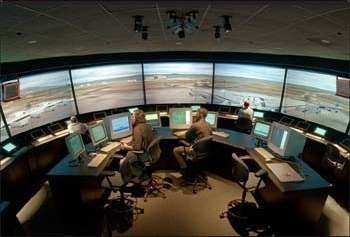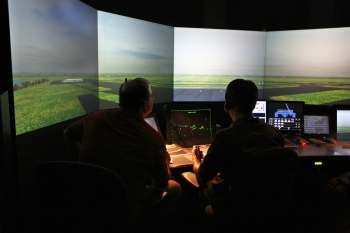Thu, Feb 07, 2008
Will Deploy Sims To 19 Airports, OKC Training Center
The Federal Aviation Administration (FAA) announced Wednesday it
will deploy new air traffic tower simulators to 19 locations around
the country to help train thousands of new air traffic controllers
in an operational environment that is interactive and provides
realistic scenarios.

The new simulators will be deployed over the next 18 months at
the following towers: John F. Kennedy (JFK); Los Angeles (LAX);
Oakland (OAK); Washington Reagan National (DCA); Dallas Fort-Worth
(DFW); Atlanta (ATL); Denver (DEN); Philadelphia (PHL); Cincinnati
(CVG); Cleveland (CLE); San Antonio (SAT); Memphis (MEM); Honolulu
(HNL); Orlando (MCO); Charlotte (CLT); Minneapolis (MSP); Boston
(BOS); and Newport News (PHF). The FAA will install an additional
six simulators at the FAA Academy in Oklahoma City (OKC).
 "We’re making sure that the
latest technology is part of the training regimen," said Bobby
Sturgell, the FAA’s acting administrator. "Controlling
traffic is a demanding job, and experience tells us that real-life
training scenarios make a critical difference. Deploying simulators
to such key locations as JFK will help us maximize our training
program."
"We’re making sure that the
latest technology is part of the training regimen," said Bobby
Sturgell, the FAA’s acting administrator. "Controlling
traffic is a demanding job, and experience tells us that real-life
training scenarios make a critical difference. Deploying simulators
to such key locations as JFK will help us maximize our training
program."
The FAA has been using tower simulators for training in Chicago,
Miami, Phoenix and Ontario, CA since 2006. In late December 2007,
the FAA awarded a contract to Adacel Systems, Incorporated of
Orlando, FL to provide another 24 simulators. Adacel, Inc.
developed the FAA’s original four prototype systems.
The Tower Simulation System (TSS) includes a large, graphic
depiction of the airfield and the area around the airport and can
be adjusted to depict different weather conditions and times of the
day. The screen showing the airfield wraps around the
student’s position to replicate windows of an actual air
traffic tower.
The simulator provides synthetic voice response and voice
recognition to allow the student to direct and receive responses as
they would in the tower. At the same time, the voice recognition
system interprets the student’s commands and translates them
into actual aircraft movements depicted on the screen of the
airfield layout.

The simulator system does not interact with actual air traffic
control operational systems and poses no threat to service
interruption. The system creates an entirely new environment that
operates away from and independently of ongoing air traffic
operations. It realistically replicates operations that enable
training in an absolutely safe environment.
More News
He Attempted To Restart The Engine Three Times. On The Third Restart Attempt, He Noticed That Flames Were Coming Out From The Right Wing Near The Fuel Cap Analysis: The pilot repor>[...]
Make Sure You NEVER Miss A New Story From Aero-News Network Do you ever feel like you never see posts from a certain person or page on Facebook or Instagram? Here’s how you c>[...]
From 2009 (YouTube Edition): Leading Air Show Performers Give Their Best Advice for Newcomers On December 6th through December 9th, the Paris Las Vegas Hotel hosted over 1,500 air >[...]
Aero Linx: NASA ASRS ASRS captures confidential reports, analyzes the resulting aviation safety data, and disseminates vital information to the aviation community. The ASRS is an i>[...]
“For our inaugural Pylon Racing Seminar in Roswell, we were thrilled to certify 60 pilots across our six closed-course pylon race classes. Not only did this year’s PRS >[...]
 NTSB Final Report: Rutan Long-EZ
NTSB Final Report: Rutan Long-EZ ANN FAQ: Turn On Post Notifications
ANN FAQ: Turn On Post Notifications Classic Aero-TV: ICAS Perspectives - Advice for New Air Show Performers
Classic Aero-TV: ICAS Perspectives - Advice for New Air Show Performers ANN's Daily Aero-Linx (06.28.25)
ANN's Daily Aero-Linx (06.28.25) Aero-News: Quote of the Day (06.28.25)
Aero-News: Quote of the Day (06.28.25)





